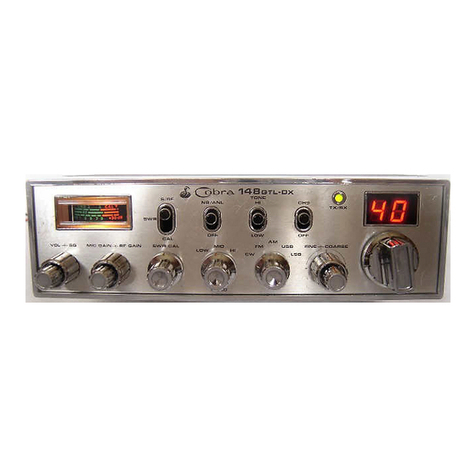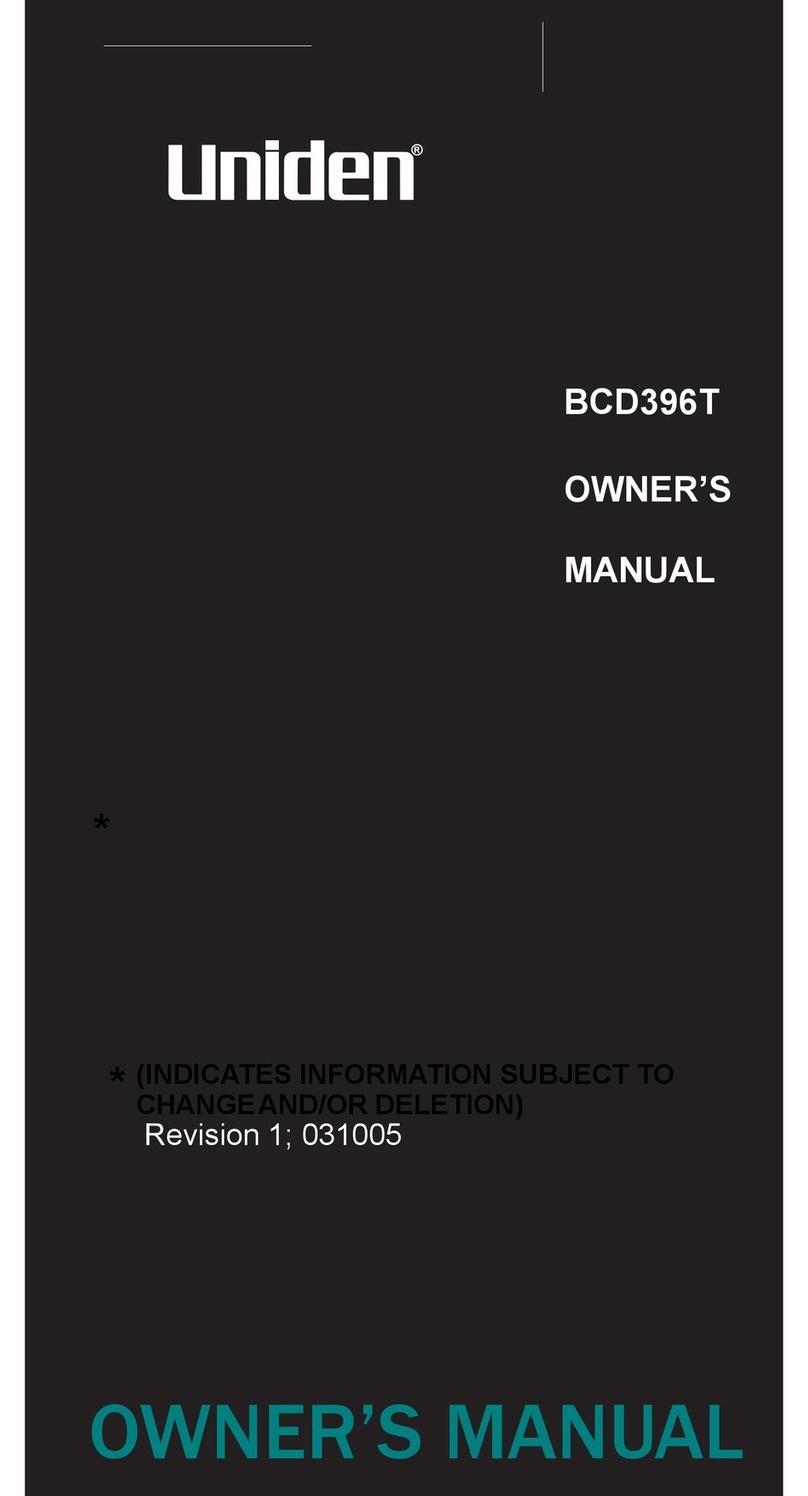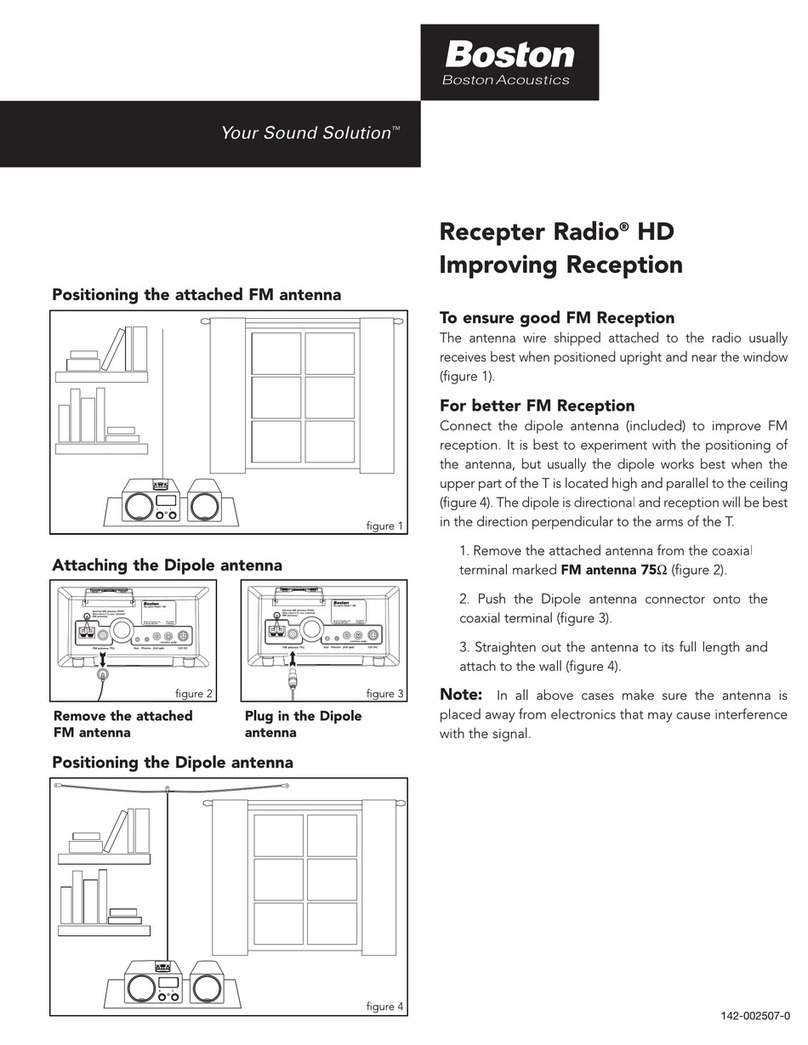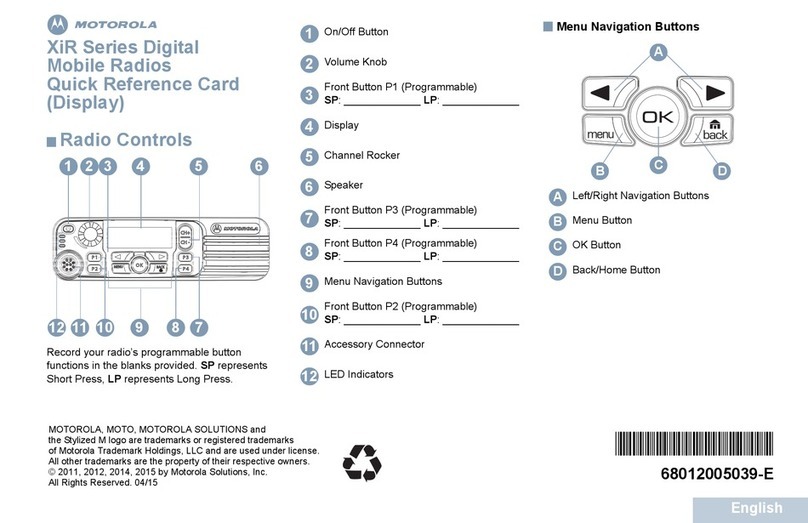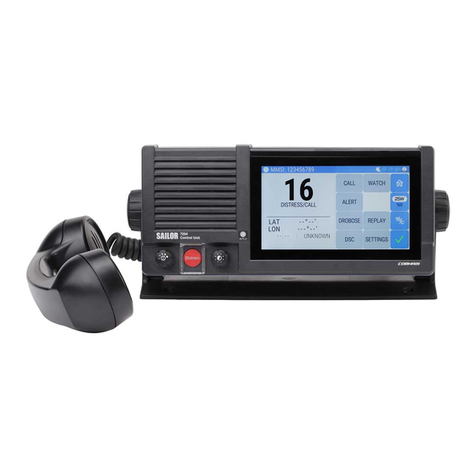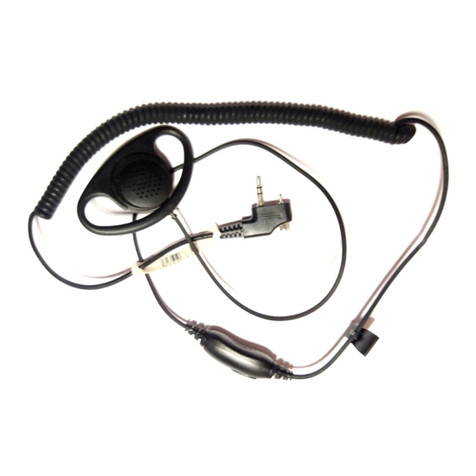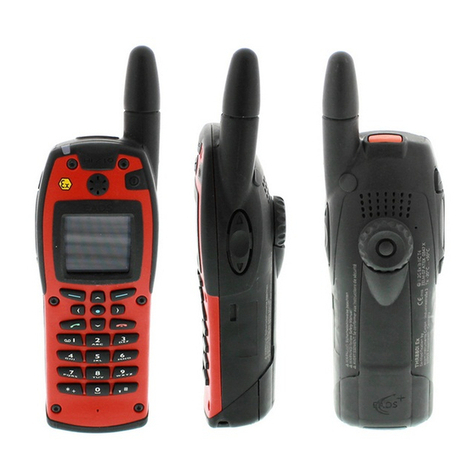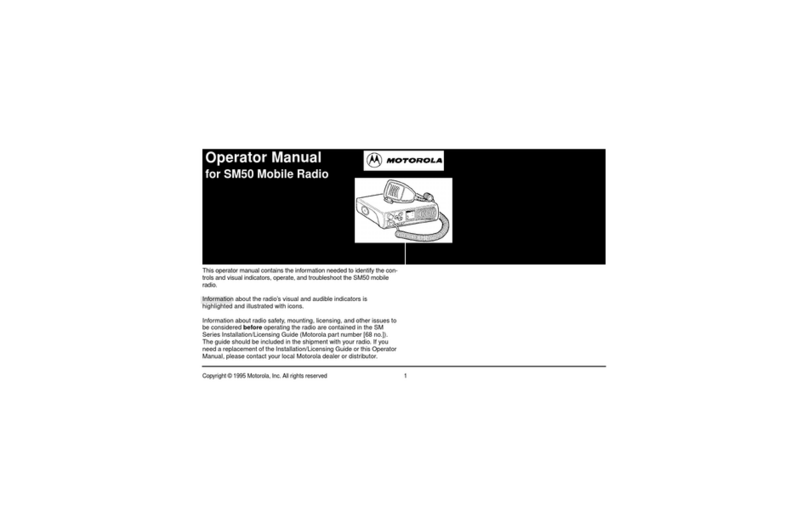Soneco SCS3 User manual

™ 1(20)
© Soneco Oy. V 28.3.2022
Staus: Contents checked Author: JR
Soneco CC3 / SCS3
USER MANUAL
SONECO Oy
Tuotekuja 5
FIN-90410 Oulu
Finland
Tel. +358 41 431 9221
e-mail: [email protected]
www.soneco.fi
© Soneco Oy
March, 2022

™ 2(20)
© Soneco Oy. V 28.3.2022
Staus: Contents checked Author: JR
This guide applies to Soneco CC3 at the time of publication i.e. March 2022.
Support for the product can be found in www.soneco.fi, e-mail support@soneco.fi via
phone +358 41 431 9221
This document, any part of it or Soneco documents referred herein shall not be
forwarded, copied, altered or re-produced in any form nor distributed on any medium
without a directly expressed permission from Soneco Oy. Soneco grants a
permission to copy this manual for the sole purpose of using the Soneco equipment
with which this document has been delivered.
The correctness and validity of this document has been verified with using
appropriate methods and care. However, Soneco does not warrant the correctness
and completeness of this document.
Soneco Oy assumes no liability for any damage, direct or indirect, that may occur
directly or indirectly to persons, equipment, material, business or financial matters
and that result from following, ignoring, abusing this guide or in other ways using the
product.
Soneco reserves the right to alter this document without further notice.
All rights reserved © Soneco Oy (Ltd.), 2022
Warranty
Soneco warrants the materials and manufacturing of the product allow full operation for 12 months
and 6 months for the battery. The warranty begins when the buyer physically receives the product.
In consumer trade Soneco is liable for the warranty defined by EU regulations.
The authorized seller of Soneco products will either repair or replace the defective device that falls
under warranty. The warranty does not apply to wear due to use or accessories. The warranty does
not apply if the device has been in wrong or inappropriate use, opened, altered, connected to other
equipment, used with other charger than Soneco P4300 or P3500. The warranty does not apply to
any effect of water, moisture or other foreign subjects or to the telecommunications network.
The application of warranty may require a valid purchasing receipt to be presented. Claim has to be
made within 2 months from the date that a defect has been found or should have been found.
Soneco Oy assumes no liability for claims that do not relate to equipment warranty.
Opening the equipment case requires an authorization by Soneco.

™ 3(20)
© Soneco Oy. V 28.3.2022
Staus: Contents checked Author: JR
List of contents
Warranty..................................................................................................................2
Purpose of CC3.......................................................................................................4
To start with.............................................................................................................4
Preparing for the use...............................................................................................4
Quick procedure for using the device for the first time ............................................5
1. Charging of the battery........................................................................................6
2. Warning message due to low battery .................................................................6
3. Start-up ...............................................................................................................6
4. The programming mode ......................................................................................7
5. The purpose and setting of the telephone numbers............................................7
6. Setting the alarm message..................................................................................8
7. Basic settings ......................................................................................................9
8. Options................................................................................................................9
8.1. Options for power ON and OFF.................................................................... 9
8.2. Options for voice calls ................................................................................ 10
8.3. Security and general settings ..................................................................... 11
9. Standby mode ...................................................................................................12
10. Making a call, sending a message, receiving a call and responding to a calling
effort ......................................................................................................................12
10.1. Starting of the calls and sending of the messages................................... 12
10.2. Receiving and terminating of the calls...................................................... 13
10.3. Receiving and terminating of the calling efforts........................................ 13
10.4. Adjusting the features of the voice call..................................................... 13
11. Special features during alarm mode................................................................13
12. Shutting the device off.....................................................................................14
13. Request for battery charge status ...................................................................14
14. Voice call features in alarm state of CC3 and SCS3.......................................14
15. Emergency call 112.........................................................................................14
16. Remote controlled voice call "CALL" and termination of a call "END CALL" and
queuing of a call ....................................................................................................15
17. The life-time, capacity and maintenance of the battery...................................15
18. The use in challenging environments ..............................................................15
19. Data security, privacy, reliability and prevention of abuse...............................16
20. Unrecognized fault situations ..........................................................................16
Annex A: Tone and light indications of CC3..........................................................17
Important to observe .............................................................................................20
Technical specifications: .......................................................................................20
Declaration of conformity:......................................................................................20

™ 4(20)
© Soneco Oy. V 28.3.2022
Staus: Contents checked Author: JR
Purpose of CC3
Soneco CC3 is a small radio device for voice calls and text messages (SMS).
With a single press of its only button, CC3 makes a voice call to one of telephone
numbers and can send a SMS to one or several numbers simultaneously.
CC3 operates in all 900 and 1800 MHz GSM mobile communication networks
with which the provider of SIM-card has a roaming agreement.
To start with
The product package includes the following:
Soneco CC3 transceiver and lanyard
Charging adapter 4300 P of P3500
User manual
Preparing for the use
Before switching the device on, one must insert a valid network operator's SIM
card (Subscriber Identity Module) in to CC3 and charge the battery. Unless a PIN
has been programmed to CC3, PIN checking has to be deactivated from SIM.
Fig. Inserting the SIM card:
Push the yellow dot with a pin in Insert a SIM to the holder and push
order to eject the SIM card holder the holder in to CC3 until it locks.
Note! When ejecting or inserting the SIM, the power should be switched OFF.

™ 5(20)
© Soneco Oy. V 28.3.2022
Staus: Contents checked Author: JR
Quick procedure for using the device for the first time
1. Switch ON the power by pressing the button (for over 5 seconds) until the
yellow light starts to blink. Release the button.
2. If the device has not been programmed before, it enters to the
programming mode automatically and the YELLOW and the GREEN
lights start blinking alternately. If the device has already been
programmed, the programming mode can be triggered by pressing the
button after the YELLOW light stops blinking and while the GREEN light
is on for 5 seconds.
3. Program the telephone numbers and if necessary, optional settings and
user specific message with sending programming SMS to the device.
4. In order to exit the programming mode, press the button shortly and
release it. In order to check the programmed data, pressing the button for
longer than 5 seconds will cause the settings to be sent as a text
message (SMS) to the first stored number if given.
5. Wait until the device switches to the power OFF state. The power is OFF
state when all the lights flash once. You can re-start the device.
6. When the device has entered the standby mode, the GREEN light
flashes in 2 seconds interval.
7. In order to switch the power OFF, press the button (for over 5 seconds)
until all lights turn on. Then release the button. CC3 switches OFF. If
switch-off by the user is blocked, see Chapter 12.
8. Please remember to charge the battery as instructed.
Programming commands can be created according to this manual or
generated with using Soneco's site www.soneco.fi/settingsaid.

™ 6(20)
© Soneco Oy. V 28.3.2022
Staus: Contents checked Author: JR
1. Charging of the battery
Insert the DC cable's plug (3,5 mm) of either SONECO P4300 or P3500 charger to
the connector on the side of the device. The progress of charging is displayed by the
brightness of the YELLOW light. If the battery is depleted, pre-charging takes place.
The stages of pre-charging are shown with YELLOW flashes. During charging, a
continuous bright YELLOW indicates an empty battery and strong charging. A dim
YELLOW indicates a relatively full battery and late stages of charging. When the
battery is full, the device gives an audible signal and switches the YELLOW light off.
The charging of an empty battery to full takes 2 to 3 two hours. Charging of the
battery can be made in any operating mode but there are no charging indications
during start-up or programming mode.
Overcharging of the battery is prevented. The charger can be continuously
connected.
In continuous use the battery charging is recommended after 3 days in use.
If the device has switched off due to low battery, it is recommended to first charge
the battery at least a few minutes before switching it on again.
2. Warning message due to low battery
If the battery charge falls below 20%, the device gives five YELLOW flashes and
audible signal. This will be repeated once in every minute until the charger is
connected. After 15 minutes of battery warnings the device sends a "BATTERY
20%" message.
If the "BATTERY 20%" message has been sent, the device sends “CHARGING”
message when the charger is connected to the device.
These messages will be sent by default to the first stored number. This option can
be deactivated or the messages directed to a different number (see Options).
Upon a detected depletion of the battery the device gives five short tones, blinks
RED and YELLOW lights and shuts down. If battery charge allows, "Battery 0%
message will be sent.
3. Start-up
In order to switch the device ON, press the button for 5 seconds. Release the button
as soon as the YELLOW starts blinking. Wait until the GREEN light starts to blink.
The device is now ready for use and registered in to the mobile network.
If the necessary telephone numbers have not been programmed before, the device
enters automatically to the programming mode.
If you wish to change the existing settings start up the device as explained
above, but press the button shortly during the start-up while the GREEN light
is on for 5 seconds. The device enters the programming mode.

™ 7(20)
© Soneco Oy. V 28.3.2022
Staus: Contents checked Author: JR
4. The programming mode
The settings for the CC3 are programmed with SMS in the programming mode. This
mode is indicated by alternating blinks of GREEN and YELLOW lights.
There are a few different ways to get the device to the programming mode. Which of
these are to be used depends on the settings of the device. The available
possibilities are explained below in chapters 4A – 4C.
4A. DEVICE WITH DEFAULT SETTINGS
Wait during start-up until the GREEN light is on for 5 seconds. Press the button
once during this period. The device enters the programming mode.
4B. A DEVICE WITH POWER-OFF PREVENTION
A device with inhibited power-OFF can be commanded to the programming mode
with a PRG-command from a number stored in the device (see 4C) or by switching it
OFF via LIMITED mode and then restarting the device. If the device is in standby
mode, it enters the LIMITED mode after removing the SIM as in Fig. 1. Remove the
SIM and wait until the device indicates a SIM-error. Return the SIM to the device.
Wait during the start-up until the GREEN light goes on for 5 seconds. Press the
button once during this period. The device enters the programming mode. Note: If
you miss the time window during the automatic re-start you can also switch the
device OFF in LIMTED mode and start it normally.
4C DEVICE WITH INHIBITED MANUAL ENTRY TO PROGRAMMING MODE
Programming mode is possible only if the device receives a <<<PRG>>> command
as SMS from a number that is stored in the device or from Soneco Oy.
EXECUTION OF A PROGRAMMING COMMAND
If a programming command is accepted and executed, the device gives an audible
signal and the YELLOW light is ON notably longer as long as the saving of setting is
ongoing. The programming mode continues.
If a programming command is rejected, the device gives three audible signals and
the RED light blinks. The programming mode continues. A rejected command is not
executed in full, i.e. part of it may have been executed.
VERIFICATION AND TERMINATION OF PROGRAMMING
Pressing the button longer than 5 seconds causes the device to send the stored
settings as SMS to the first number if it is given.
Programming mode is terminated with a short press of the button. The device shuts
off.
5. The purpose and setting of the telephone numbers
Number1, Number2 and Number3: After a single press of the button, CC3 tries to
make a voice call to these numbers. The length and the number of attempts to
make the voice call can be defined with the parameters of the calling engine.
X-number and U-number: CC3 has option to set a 4th X-number and a 5th U-
number. The X-number (eXtra number) can be used as an emergency number for
situations when the numbers 1 to 3 can not be reached. In CC3, the X number is for
voice calls. The U-number (Unlocking number) is only for the management

™ 8(20)
© Soneco Oy. V 28.3.2022
Staus: Contents checked Author: JR
purposes. The U number can call or control the device but it can not normally be an
alarm call or a message number.
Telephone numbers are set in the programming mode with sending them as single
SMS. The message has to contain all numbers between command brackets "<<<"
and ">>>" and separated by semicolon and without spaces as below.
<<<number1;number2...>>>.
<<<+358414319220;+358414319221;+358414319221>>>
or <<<+358414319221>>>
If the X-number is in use, it has to be given before the numbers 1 to 3.
<<<Xnumber4;number1;...>>> ,
<<< Xnumber4;number1;number2>>> or
<<< Xnumber4;number1;number2;number3>>> .
If the U-number is used, it shall be given after X-number and before numbers 1-3:
<<<Unumber4;number1;...>>> or
<<<Xnumber5; Unumber4;number1;...>>>
Any number command replaces all previously stored numbers. A command
<<<EN>>> erases all numbers (Erase Numbers). If <<<EN>>> is rejected, the
command is <<<CLRN>>>.
6. Setting the alarm message
Unless the alarm message has been set by the user, the message is ”SOS
ALARM”.
The message is set in programming mode with a message to the device. The
message has to contain between command brackets “<<<” and “>>>” a command
"sms:" and the message with a maximum length of 150 characters as below
<<<sms:Own_message>>>
E.g.<<<sms:Contact reception>>>

™ 9(20)
© Soneco Oy. V 28.3.2022
Staus: Contents checked Author: JR
7. Basic settings
The basic settings define how the device makes the calls and sends the messages
when the button is pushed. The basic settings have been set according to
customers’ wishes by Soneco during the manufacturing. These basic settings can
be altered with the programming command
<<<CCxabc>>>
The character x with value 1, 2 or 3 defines how many telephone numbers can be
included in the list of numbers to be called. The characters a, b and c have a value
1 or 0 and they define whether a message is to be sent (value = 1) to the
corresponding numbers or not (value = 0). The character “a” defines if the message
is to be sent to number 1, “b” means the same for number 2 and “c” for number 3.
E.g. a command “<<<CC1110>>>” defines CC3 to call only number 1 and to send
message to numbers 1 and 2.
8. Options
The device offers several options. The options are set or altered in programming
mode with commands indicating the option with a capital letter followed by "1" to
activate the option or "0" to deactivate it. All default values are "0".
The device has the following options:
8.1. Options for power ON and OFF
P1/P0 Disable power-OFF by the user. The device does not switch off from standby
mode with a 5 seconds press. Presses up to 9 seconds are interpreted as short
presses.
F1/F0 Forced power-ON. The device turns itself ON automatically if the battery
voltage is high enough or becomes high enough during the charging.
Wxxxxxy Selection of the battery warning message recipients. All x-values have to
be given and be “1” or “0”. With “1” battery warning is sent to corresponding number
and with value “0” it is not sent. The first x value is for the first number, the second x
for the second number etc. The 4th x is the X-number and the 5th x is the U-number
(See chapter 5). No warning will be sent with the command W00000. The default
setting is no battery warnings i.e. corresponding to command W00000. Battery
warnings will be sent only if corresponding numbers are given. E.g. W00100 causes
the message to be sent to the 3rd number if given.
The default warning level is at 20% of battery capacity or y=1. A value y=2 means
warning at 40% and y=3 warns at 60%. With value y=0 also audio warnings are
switched off. For values 20%, 40% and 60% also audible warnings are active.
"Battery 0%" warning remains always active. In vibrator/buzzer devices audible
indications can be silenced with deactivating the buzzer tones with a D-setting.
S1/S0 Skip entry to programming mode: The 5 second time window during the
start-up for user to enter the programming mode is skipped. Programming mode is
possible only via a SMS command “<<<PRG>>>” from a number stored in the
device. See also Chapter 17.

™ 10(20)
© Soneco Oy. V 28.3.2022
Staus: Contents checked Author: JR
8.2. Options for voice calls
T1/T0 Reject incoming calls. In the standby mode all incoming calls are rejected
unless coming from a number stored in the device.
C1/C0 Automatic answering of incoming calls. The device opens an acceptable call
after three rings.
B1/B0 Button sensitivity. Presses shorter than one second will be ignored.
E1/E0 Call to the emergency number 112. Command E1 allows a 112 call in
standby mode. If the button has been pressed for longer than 10 seconds, 112 call
processing will start. The setting E0 (default) prevents 112 calls in the standby
mode. In the LIMITED mode the emergency 112 calls are always possible.
V1/V2/V3/V4 Setting for earpiece audio volume. V1 is suitable for silent
environment when holding the phone on the ear. V2 is louder and suitable for
environments with background noise. V3 allows some speaker-phone function in
silent environment. V4 is the maximum setting with which the phone should not be
pressed directly to the ear.
Gx (x = 1 - 7) Sensitivity of the microphone. The setting G7 (default) is the most
sensitive and causes the full audio level to the receiver also from a weak voice and /
or from a noticeable distance (say 1 m) from the device. With a setting G1-G2 full
audio volume will be reached only when speaking directly to the microphone from a
short distance or nearly in contact with the microphone. The G-setting does not
affect the audio level of the voice call but only the conditions where the full level is
reached. With G7, distortion may occur when speaking loud directly to the
microphone.
Ix (x = 0 - 7) Ringing tone volume. The setting I0 means a silent call and I7 (default)
the highest ringing volume. The ringing tone comes from the loud-speaker of the
phone that is used also as the earpiece. The setting x4=1 of R-setting inhibits
vibrator alert for incoming calls thus facilitating totally silent alert.
OxHy (x = 0 - 9, y = 1 - 9) Settings of the dialing procedure. Here x is a number
from 0 to 9 that defines the amount of full dialing sequences. With x=0 the
sequential dialing procedure is not in use. The value y is the duration of each dialing
effort in multiples of 5 seconds. Y must be from 1 to 9. As an example,
<<<O3H4>>> sets the dialing sequence to be passed three times and to last 20
seconds for each number.
Dxxxxx or Dxxxxxz Dialing indications. The five (5) x-values define tone elements
during call processing and an option y. For each tone, 1 = ON, 0 = OFF. x1 is the
button tone from the buzzer upon initiation of the call and all other button presses.
x2 is the dialing tone from the device during call initiation process. This tone is
generated by SONECO device itself and comes from the earpiece. x3 is the
stepping tone of calling machine. It is buzzer beep which is heard each time the
calling machine starts to call the next number. x4 is the ringing tone from the
network as audio signal to earpiece . x5 is a buzzer beep when the called party
picks up, i.e. goes to off-hook and the audio line to called party is open. For text
messages, only x1 is relevant. The default setting for CC3 is that all tones 1 to 4
are ON. In elder devices this setting is fixed and tone 1 and 5 do not exist.
“<<<D00001>>>” causes CC3 to give buzzer signal only after the audio line to
called party is open. All other indication tones are OFF.

™ 11(20)
© Soneco Oy. V 28.3.2022
Staus: Contents checked Author: JR
The option z is for devices with a vibrating indicator. With z = 0 the tones are off
and ON with z=1 tones are on with medium volume. If z is blank, the tones are on
with maximum volume. Even when tones are silent by global setting or temporary
setting I0, the vibrator still runs for incoming call unless blocked by setting x4 (see
settings I and R).
8.3. Security and general settings
PIN:12345678 PIN-checking. This command sets PIN-checking on and the value
for the PIN-code given. If the PIN has been set, the device responds to the first PIN
query with the given PIN code. The SIM card has to be set for the PIN with using
e.g. a normal mobile phone. If the PIN code is wrong or the SIM card has
experienced earlier PIN errors, a SIM error will be indicated. It is possible to
continue using the device with a SIM without PIN checking. Re-programming the
PIN is possible but there is no need to erase it.
N0/N1/N2 Controls for the calling line indication. With N0 the device sends its own
number as defined by the network. With N1 the device instructs the network not to
send the calling line number. With N2 the device asks the network to send the
calling line number.
Rxxxxxyyy: Voice call settings in alarm mode. Values y1-y3 and x5 apply to CC3
and values x1-x5 apply to alarm mode call from MC3. For CC3, the following
instructions apply if there is no answer from the called numbers:
y1 = 1 causes a text message to be sent to the X-number (see chapter 5) if there is
no reply from numbers 1 to 3.
y2 = 1 causes a call to X-number if there is no reply from the numbers 1 to 3.
y3 = 1 causes the user's option to select the called number to be skipped in the
calling engine. Note that with y3 = 0 the user can select the number to be called (if
more then one stored) See chapter 10.1 for selecting the number. The cyclic
operation of the calling engine can be skipped also with O = 0 which defines the
amount of cycles as zero.
x5 = 1 inhibits vibrator alert for incoming call and thus facilitates entirely silent alert if
ringing tone has been set silent.
M0/M1/M2/M3 The timing of the text messages in the calling sequence. With M0
the device sends the message upon the pressing of the button. With M1 the device
sends the message if the user has not selected a number to be called or this
selection for the calls is not in use. With M2 the device sends the message only if
there is no reply for the calls, i.e. the calling engine stops the operation or calls the
X-number. No message X-number is sent if the parameter y1 does not indicate this
operation or the basic setting does not include the sending of a text message. With
M3 the messages will be sent before starting the calling procedure (recommended).
SPIN:Ab1& Security code for management commands in standby mode. If the
code is set, access from the SONECO's service number requires a correct SPIN.
SPIN is four (4) upper or lower case characters, numbers or other characters of
basic ASCII. The associated commands are the inquiries for battery status, log data
and network parameters and the command to enter the programming mode.
SPIN: Deactivation of SPIN, i.e. with the command "<<<SPIN:>>>". The
management commands are possible from stored telephone numbers and

™ 12(20)
© Soneco Oy. V 28.3.2022
Staus: Contents checked Author: JR
Soneco's own nonpublic telephone number. The management commands and the
use require additionally, the telephone number of the device to be known.
The options can be programmed one by one (e.g. <<<P1>>>) or combined in to a
single command e.g., to the following example command
<<<S1F1P1W01100>>>
which sets the device to skip the manual entry to programming mode, forced power-
ON, prevents power-OFF in ready state and directs battery messages to numbers 2
and 3. Commands containing character data i.e. commands PIN, DIMSG, SPIN and
SMS, have to be send all individually,
9. Standby mode
The device enters the standby mode after start-up if the phone numbers are
available. The standby mode is indicated by GREEN blink every 2 seconds. The
device is ready for making calls and sending messages.
If the network connection is lost more than very temporarily, the device gives an
audible signal and starts to blink RED. If the network connection can be restored,
the GREEN blinks will be resumed. The reasons for network losses should be
clarified with the network operator and, if available, with the receiver of alarms.
10. Making a call, sending a message, receiving a call and
responding to a calling effort
10.1. Starting of the calls and sending of the messages
Making a call will be triggered by a short press of the button. The calling engine
goes through three following three stages:
Stage 1: The user can select a number of the numbers 1 to 3, as the number to be
called. The device waits 5 seconds for a press for each number. A press during
GREEN blinks selects number 1. A press during YELLOW blinks selects number 2
and a press during RED blinks selects number 3 (see setting R).
Stage 2: The device makes calling efforts in a sequence to numbers 1, 2 and 3. The
duration of ringing for each number and the number calling cycles can be set with
setting H and O.
Stage 3: If none of the numbers 1 - 3 has responded, a call (or message) is made
to X-number as has been set by the appropriate settings (R and M).
The execution of calling effort to several numbers may take a lengthy time. It may
be useful to make the user familiar with these times and to set the indications (D-
settings) to indicate the different stages.
If the calling of telephone numbers becomes delayed or interrupted for the network
reasons, the YELLOW blinks rapidly during the delay. The efforts to call continue
after the delay. If the delay does not disappear, the device gives three audible

™ 13(20)
© Soneco Oy. V 28.3.2022
Staus: Contents checked Author: JR
signals and RED blinks. If the reason for failed transmission is lost network
connection, the device enters LIMITED state. Wait until the device returns to
standby mode and re-start the calling by pressing the button.
A failure to make a call should be very rare and should not occur without a reason,
such as overload in the network, operation in the boundary areas of network
coverage, or weak radio signal inside a massive building, or a defective device.
10.2. Receiving and terminating of the calls
The device indicates an incoming call with a melodic ringing tone at the volume set
by the user, and with alternating blinking of all lights. Ringing tone may be switched
off so that only light indication appears. If the device has vibrator, incoming calls are
indicated also with periodic vibrations.
An incoming call is responded with a short press of the button. A long press rejects
the call.
If automatic answering is active the call is answered after the third ringing tone.
The device may have been set to reject other calls than calls from stored numbers.
Such cases are not indicated at all.
A call is terminated with a short press of the button. If the other party terminates the
call first, the connection with the device is terminated also automatically.
10.3. Receiving and terminating of the calling efforts
When the calling engine is making efforts to set up a call, the device directs the call
to such a stored number from which it first receives SMS and terminates the further
operation of the calling engine.
The user can terminate the calling efforts with a short press of the button.
10.4. Adjusting the features of the voice call
Prior to a call in standby mode or alarm mode, the audio volume in earpiece can be
adjusted with a V-command, the sensitivity of the microphone adjusted with G-
command and the level of the ringing tone with I-command with the exception that a
silent call in alarm mode remains silent. As an example, the command
"<<<V2G6I5>>>" sets earpiece volume level 2, the microphone sensitivity to level 6
and the ringing volume level 5. The adjustments made in standby mode apply for
the next call after which the programmed settings apply.
In most versions the sound level of the earpiece can be adjusted also during the call
by sending the V-command during the call.
11. Special features during alarm mode
CC3 is in alarm mode only when it is trying to make a call with the calling engine.
During this mode the call can be directed to the stored number that sends a
message to the device. This mode can be terminated with a press of the button
after which the device returns to the standby mode.

™ 14(20)
© Soneco Oy. V 28.3.2022
Staus: Contents checked Author: JR
12. Shutting the device off
When allowed, the user can switch off the device with pressing the button for over 5
seconds, until alls lights switch on, and releasing it before 10 seconds. The device
gives an audible signal and shuts down the lights one by one. Shut-off is completed
when all lights flash once.
If shutting the power-off has been inhibited, the device can be shut off via LIMITED
mode. Remove the SIM as seen in Fig. 1 and wait until the device tries a new start-
up, indicates a SIM error and enters the LIMITED mode wit continuously blinking
RED. Press the button as above, i.e. for 5 seconds. The device shuts off and will
start only via pressing the button i.e. not due to the forced-ON.
13. Request for battery charge status
The device reports the battery status in standby mode as a reply to the message
<<<battery>>>. The message has to be sent from a number that is stored in the
device. The device responds to the same number with a message containing SW
version code, estimated remaining battery capacity in %, battery voltage in mV and
the information about whether a charger is connected and a call ongoing.
14. Voice call features in alarm state of CC3 and SCS3
CC3, SCS3 or MC3 can be programmed to other device type If CC3 is
reprogrammed to MC3, please refer to User's Guide for MC3.
15. Emergency call 112
The CC3 device can be set to allow emergency 112 calls in standby mode.
If emergency calls are not in use, the device will shut off after pressing the button for
5 seconds and releasing thereafter. If shutting-off is not allowed, the device makes a
call and sends the associated messages
If emergency calls are enabled, pressing the button continuously for 10 seconds
causes all lights go on 5 seconds thereafter and an audible signal at 10 seconds.
Releasing the button at this point would shut the device off if allowed, or trigger the
call if shut-off is blocked. Continuing the pressing beyond this point the device gives
two short audible signals and flashes all lights three times. Continuing to press
beyond this point triggers an emergency call. This is indicated by the RED light.
Accordingly, releasing the button at this stage will return the device to standby.
A triggered emergency call can be terminated with pressing the button again.
In the LIMITED mode a long press beyond 10 seconds will always trigger the
emergency call as above.
A simplified, easy to remember emergency call instruction: press the button until the
RED light is continuously on. Continued pressing the button after this or releasing it
has no effect. Pressing the button again will terminate the emergency call.

™ 15(20)
© Soneco Oy. V 28.3.2022
Staus: Contents checked Author: JR
16. Remote controlled voice call and queuing of a call
The telephone numbers stored in CC3 can command the device to make calls and
to terminate ongoing calls.
A call to the number-x is triggered with a command <<<CALL:number-x>>> if the
dialing indications x2 and x4 are active. Accordingly, the device gives a clear sound
indication from such a commanded call. If the dialing indications are not in use,
CALL-command will be rejected i.e. making commanded silent calls is not possible.
A CALL-command arriving during an ongoing call will be rejected. An ongoing call
can, however, be terminated remotely by sending a blank command <<<CALL:>>>.
After this a new CALL-command is available. This makes it possible to make a call
in emergency situations if the line has left open.
If the SIM-settings allow for a queuing call, a queuing call will be indicated with the
audible network signal from the earpiece. Pressing the button during a queuing call
will immediately terminate the ongoing call and trigger the ringing tone for the
queuing call. Queuing is a service setting of the subscription.
17. The life-time, capacity and maintenance of the battery
The re-chargeable Lithium battery of the device has a typical life time of 400
charge/discharge cycles, or 2 - 5 years in use. Along with the use, the stand-by time
with one charge decreases. On the same, the likelihood increases for the device
shutting down due to low battery capacity or at low temperatures.
The battery capacity is relatively insensitive to the depth of charging cycles, i.e. the
battery can be charged frequently and only partly discharged or less frequently in a
more discharged state.
The device monitors also the accumulated charge flow from the battery and
estimates the remaining battery charge. The device can make a better estimate if
the battery is allowed to discharge down to 20% level at least a few times.
It is recommended to change the battery in ca. 3 year intervals or when the stand-by
time with a fully charged battery falls below 3 days.
Changing the battery has to be done by an authorized service.
18. The use in challenging environments
The capacity and the current capability of Lithium batteries degrade strongly at low
temperatures (e.g. below 0 °C). In outdoor use it is recommended to carry the
device so that it remains at body temperature, e.g. in a warm pocket. If the device
has shut itself down at low temperature, it may still operate properly, at least for
some time, at higher temperature. Body temperature is ideal.
The connection may be lost from time to time or calls or messages can fail. In such
circumstances messaging and calls may still be possible when going out from inside
the buildings, avoiding any shadowing of the earpiece end of the phone (e.g. by the
hand) or with rising to a higher elevation within the building or in the landscape.
Charging the battery is possible only at temperatures between 0 and 45 °C.

™ 16(20)
© Soneco Oy. V 28.3.2022
Staus: Contents checked Author: JR
19. Data security, privacy, reliability and prevention of abuse.
The user of the device, the service provider and other numbers stored in the device
have certain powers to use the device and the telecommunications account (i.e.
credit) that rely on the device and its SIM remaining in the intended hands and use.
Exceptional situations are to be considered.
The device does neither store nor forward information about calls or messages. The
device stores and may forward information about network events that affect the
quality of service upon a request by text message from stored numbers, It is not
possible to re-program the device and put it in to use as re-programmed without
physical interaction by the user.
An authorized user (i.e. the stored phone numbers) may request the device to send
network data which allows detecting the location of the device within a radio cell, i.e.
normally within or less than a few kilometers. The device stores the events of
network losses, switching the device on or off and device's internal errors. In the
service this data can be read with date and time stamps.
The real time clock of the device becomes synchronized with the network time at
every programming message. The clock will be reset to certain old date if the battery
protection circuitry switches the voltage supply off due to deep depletion.
If an entry to the programming mode by the user has been prevented and the users
have lost the information for sending and acceptable PRG-command, the GSM
phone number of Soneco's service can command the device in to programming
mode and read the technical information. This number can not control the calls or
the messages nor can it be used as a calling number. Upon request, this feature can
be erased at the delivery or made by the user subject to correct SPIN.
The device has been designed so that it could not be disturbed or made non-
functional through the network and can not be accessed without authorization.
The abuse of the device or the telecommunications account can be prevented by
PIN and with setting appropriate service and/or service limitations.
20. Unrecognized fault situations
The device has been designed to operate in all known situations and to recover from
fault situation and indicate such to the user. In order to trace the fault situations, the
device maintains an event register (log book) about events relevant to service.
In the case of unrecognized errors, the device remains in error situation and shuts
itself down or goes to sudden shutdown. The cause for such may be
- wrong or faulty charging device
- wrongly set PIN code or prior effort with a wrong PIN
- SIM card contact error e.g. due to falling of the device, it being hit or poor insertion
of the SIM-card .
- empty battery or total loss of battery capacity
- entry of water, humidity or foreign objects inside the equipment case
- otherwise broken and non-functional device.
- uncontrolled removal of SIM or shut-down of equipment
Unrecognized errors should be very rare. The reason should always be cleared even
if the device may return later to normal operation.

™ 17(20)
© Soneco Oy. V 28.3.2022
Staus: Contents checked Author: JR
Annex A: Tone and light indications of CC3
A1. When the device is OFF (OFF mode)
The OFF is nt indicated. Upon pressing the button, the device gives and audible
signal and the YELLOW light is on.
If there is no indication from the button, the battery is empty and needs charging.
A2. OFF mode with connected charger
The connection of the charger causes an audible tone and the YELLOW light is on
with the brightness according to the voltage. The beginning of charging will be
indicated with three tones and bright YELLOW flashes. After this, the progress of the
charging will be shown with YELLOW light:
In the case of deep discharge, connecting the charger causes no tone. The stages
of pre-charging will be indicated as follows:
- YELLOW flash once on 4 seconds: Pre-charging makes progress.
- YELLOW ON/OFF in 2 seconds: Fast charging being started.
- YELLOW on and bright: Fast charging, nearly empty battery, strong charging
- YELLOW dimmed = nearly full battery
- No light: Battery full.
Two audible tones and YELLOW flashes. Charging completed and battery full.
Continuous RED when the charger connected or during charging: Over voltage of
the charger or battery. Faulty or wrong charger, or a faulty battery
A3. During start-up
Upon pressing the button for over 5 seconds the YELLOW starts to blink. Releasing
the button initiates the start-up of the device. YELLOW continues to blink in ca. 1
second intervals.
Three tones and RED flashes in an early stage of start-up indicate a SIM error,
missing SIM, PIN-error or missing PIN. The start-up continues. After a new SIM/PIN-
error indication the device enters the LIMITED mode.
RED starts to blink frequently: LIMITED mode.
It is not possible to interrupt the start-up but pressing the button for more than 10
seconds causes a reset and new start-up.
During start-up there is no indication about charging. After the start-up the status of
charging will be indicated again.
A4. In standby mode
At the beginning of ready state GREEN is on for 5 seconds if the entering the
programming mode by pressing the button is allowed.
GREEN blinks every 2 seconds: standby mode OK.
RED blinks: Network connection lost for the time being, recovery efforts ongoing.
RED Blinks and tones: SIM error. The device will be switched off and re-started.
GREEN, YELLOW and RED blink alternating with a melodic ringing tone. Incoming
call. Note that the call may be set as silent.
Tones and YELLOW blinks in ca. one minute interval: Battery charge low.

™ 18(20)
© Soneco Oy. V 28.3.2022
Staus: Contents checked Author: JR
GREEN, YELLOW and RED go on after pressing the button for 5 seconds. The
device will shut off if the button is released. A shut off takes place also if the
pressing is continued and emergency call disabled.
GREEN, YELLOW and RED start blinking simultaneously three times with a tone
after ca. 10 seconds of pressing the button. Warning for emergency call 112.
Releasing the button will terminate the processing of the emergency call, a
continued press will trigger the emergency call.
GREEN continuously on: Message is being sent or voice call ongoing to number 1
out of 2 or 3 numbers.
YELLOW continuously on indicates a call to number 2.
RED continuously on: emergency call ongoing, a call to only number or to number 3
out of three numbers..
A5. When making a call and sending the message
When only on telephone number (i.e. setting CC1xxx) out of three stored:
The RED light indicates that a call / message sending is active. The RED light is
switched off when the call has been terminated and messages sent. If messages
are sent before initiating any call (setting M3), GREEN is on as long as messages
are being sent.
When two or three normal telephone numbers (settings CC1xxx or CC3xxx) stored:
Frequently blinking GREEN light and then frequently blinking YELLLOW light: The
device has two stored numbers to be called and the dialing engine is waiting for the user to select one.
Pressing the button during the blinking GREEN light initiates dialing to number 1. Pressing the button
during the blinking YELLOW light initiates dialing to the number 2.
Frequently blinking GREEN light and then frequently blinking YELLLOW light and
then frequently blinking RED light: The device has three stored numbers to be called and the
dialing engine is waiting for the user to select one. Pressing the button during the blinking GREEN light
initiates dialing to number 1. Pressing the button during the blinking YELLOW light initiates dialing to
the number 2. Pressing the button during the blinking RED light initiates dialing to the number 3.
Each light blinks for 5 seconds.
If audible indications are activated in to use:
During freguenlty blinking GREEN: ------ (beep)
During freguenlty blinking YELLOW: ------ -- ("beep bip)
During freguenlty blinking RED: : ------ -- -- ("beep - bi -bi))
In all cases:
Three tones and RED light: Connection failed. The user can re-try.
Three tones and RED lights followed by frequent blinking RED light: Network
connection lost. The user can re-try after the GREEN blinking resumes.
Continuously burning GREEN, YELLOW or RED light: Dialing or connection is
ongoing to the corresponding number.
A6. Standby mode when connected to the charger
The device indicates the progress of charging with the brightness of YELLOW and
standby mode with GREEN.
A7. In LIMTED mode
The RED blinks continuously in 0,5 second interval. The device in LIMITED mode
for following reasons: No SIM, SIM error, PIN-error, no network coverage. The only
possible actions are the shut-off and an emergency call.

™ 19(20)
© Soneco Oy. V 28.3.2022
Staus: Contents checked Author: JR
If network coverage returns, the device returns to the standby mode.
In the absence of SIM or network coverage, the emergency call will be tried with the
best available network. During an emergency call a shut-off due to low battery is
blocked. The call remains on as long there is any charge in the battery.
A8. Acoustic / vibration indications (A1)
Acoustic indications are activated with A-setting (A1) and extended to response type
indications through activating the button delay with B-setting (B1). The indications are below.
Short tone is "bip" long "bee" and the longest "beep", pause as "-" and long pause "----".
Short press on off mode: "beep",
long press in off mode "beep", -5 seconds -- "beep",
SIM-error of LIMTED state "bee" -- "bee" --- "bee"
Short press "bip"
Long press in ready state "beep"
Accu 20% "bip"
Accu 0% "beep - beep -beep"
accu depleted and switch off ""bip" "bip" "bip" "bip" "bip"
Upon number selction indicating LED colors (brackets repeated continuously=
GREEN ------ (bee ---)
YELLOW ------ -- (bee - bip)
RED ------ -- (bip - bip - bip ----).
Charger connected bip - bee - bip
General double tone bee --- bee (eg. when battery full)
Wait state -YELLOW, no tone
Switch off bip - bip - bip
Start of ready state bip - bip -(in start-up, after a call)
Confirrmation of action (none)
Rejected press (none)
IF the device is switched off, in ready state or LIMITED state and, additionally, if button delay (1
sec) has been set, a short press less than 1 sec triggers audio (and vibrator if present)
indication of current status as follows:
SWITHED OFF: Button delay is not active. Pressing the button triggers an immediate "bip" and
if pressed further for 5 sec, another "bip" and starts the device. If pressing is extended
beyond 10 sec, the stops and restarts.
IN READY STATE: The response is "bip bip" indicating the ready state. If pressed beyond 5 sec
and released before 10 sec, the device executes the command that has been defined for it.
IN LIMTED STATE: The response is "beep -- beep -- beep " as a status indication. Extending
the pressing beyond 5 sec and releasing before 10 sec, the device switches off. Pressing
beyond 10 sec triggers an emergency call and indicates this with repeated "beep" tone.
While starting up or in waiting: The button is inhibited and there is no response to pressing it.
A9. When using vibration indications
Devices having been updated to use vibrator are designated as CC3v etc. and or if updated to
use both vibration and sound indications, the device type is CC3vs etc.
The vibrations and tones are slightly longer than when using tones only.
The sound frequency is ca. 600 Hz in order to be in the human ear's stereo hearing range
which helps in locating the device according to the sound. See D-settings.

™ 20(20)
© Soneco Oy. V 28.3.2022
Staus: Contents checked Author: JR
Important to observe
Keep the device switched off in hospitals and near health care equipment,
such as pacemakers and hearing aids. The device may interfere with the
operation of such equipment. If you have a pacemaker, do not carry the
device around your neck.
Keep the device switched off when travelling in an airplane. Make sure
that the device is not switched on accidentally.
Switch the device off at gas stations, fuel or chemical storages and
blasting areas. The device may interfere with the operation of technical
equipment.
The device may cause interference near TVs, radios and computers.
Disposal of the transmitter part allowed only as an electronic device
containing Lithium battery. Disposal according to EU directive for
Directive
2012/19/EU on waste electrical and electronic equipment (WEEE).
Due to Lithium polymer or Lithium Ion rechargeable batteries, special
instructions to storage, transport and disposal of CC3 apply.
Phone network: dual band GSM 900/1800 MHz
Antenna: integrated
Weight: 58 g without the carrying lanyard
Dimensions: 64 x 41 x 23 mm
Battery: Li-Ion 600 mAh or larger 900 or 1000 mAh
Standby time: > 72 hours
Speaking time: > one hour
Charging time: ca. 2 hours to 100 %, 3 h with 1000 mAh
Operating temperature: -10 ... + 55 C (when charging, 0 ... + 45 C)
SIM card: 3,0 V
SAR: < 0,5 W/Kg
Operating voltage: 3.7 V
0523
Declaration of conformity:
The product complies with the requirements of the European Council
directive 1999/5/EY.
This manual suits for next models
1
Table of contents
